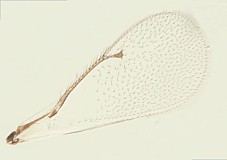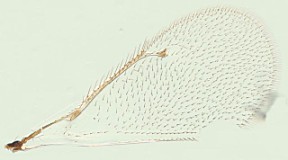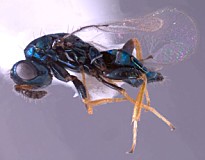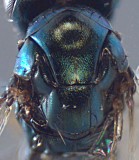The genus Tetrastichus was formerly one of the largest genera in the Chalcidoidea. The reclassification proposed by Graham (1987), in which Tetrastichus was broken up into several smaller, more natural groups, has been widely accepted by other workers. Tetrastichus in its reduced form is now the third largest in the subfamily Tetrastichinae of the family Eulophidae. Tetrastichus is cosmopolitan in distribution, but the species that have been most commonly associated with fruit-infesting Tephritidae are of African origin.
Tetrastichus
Remarks
The species of Tetrastichus that attack fruit-infesting Tephritidae in Africa were reviewed by LaSalle and Wharton (2002), and much of the information presented here is taken from that source.
Description
A key to the three species reared from fruit-infesting Tephritidae is provided by LaSalle and Wharton (2002). The ability to differentiate these species is particularly crucial to studies attempting to verify apparent differences in patterns of host utilization by the various eulophids that have been reared from tephritids. All three species are found in Kenya, where they were reared from various wild fruits in our recent survey of tephritid fruit flies and their parasitoids from that country (Copeland et al. 2009). Previously published host and distribution data are summarized in LaSalle and Wharton (2002). Tetrastichus giffardianus is readily separated from the other two species by the absence of setae in the broad area near the base of the fore wing (Figure 1). The other two species have the normal complement of setae in this region (Figure 2), and are separated from each other by differences in ovipositor length and shape of abdomen.
Distribution
Tetrastichines are commonly enountered in studies of the parasitoid fauna of tephritids in Africa, but native tetrastichines appear to be absent from the parasitoid community attacking New World tephritids. An unknown species of Tetrastichus was reared from cultivated olives in South Africa (Neuenschwander 1982), and from olive fly, Bactrocera oleae, in Jordan (Mustafa and Al-Zaghal 1987).
Distribution
No referenced distribution records have been added to the database for this OTU.
Biological Control
At least three species have been collected in association with biological control programs: Tetrastichus giffardii Silvestri (=T. dacicida Silvestri), T. giffardianus Silvestri, and T. oxyurus Silvestri. Though attempts have been made to introduce all three species to Hawaii, apparently only T. giffardianus is now established outside its native range. This species has been studied in association with medfly and Oriental fruit fly in Hawaii and was mass reared and released against medfly and native pests in Brazil (Fonseca & Autuori 1940; Fonseca 1947). It is a gregarious, koinobiont, larval-pupal endoparasitoid (Silvestri 1913; Clausen 1978; Ramadan and Wong (1990); Purcell et al. 1996). Tetrastichus giffardianus oviposits into mature host larvae, and the adults emerge from young pupae after the puparium is formed. It has also been studied in Hawaii relative to non-target effects (Purcell et al. 1997; Duan and Messing 1998).
Map
There are no specimens currently determined for this OTU, or those specimens determined for this OTU are not yet mappable.





